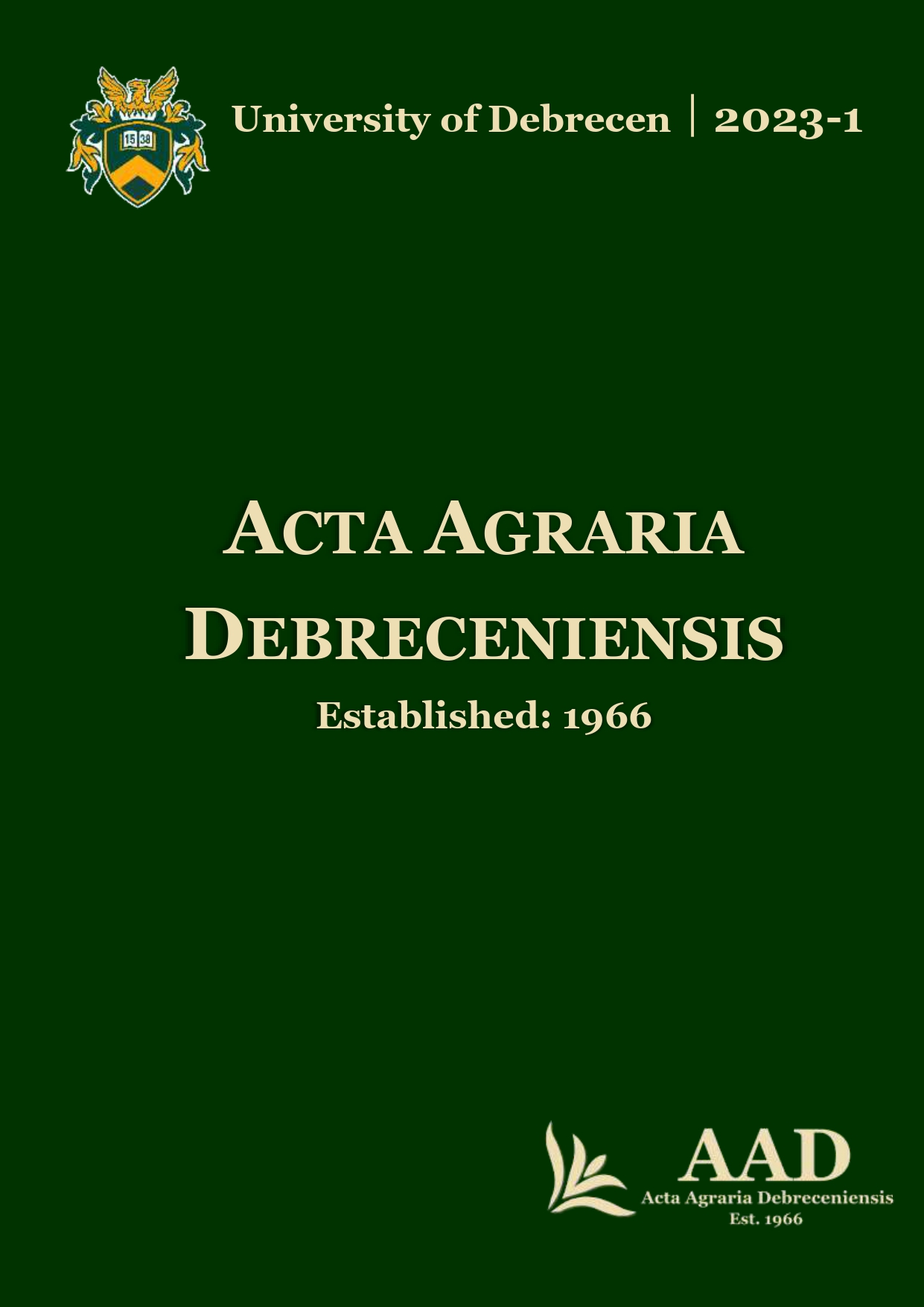Investigating the above-ground biomass values of sweet potatoes (Ipomoea batatas)
Authors
View
Keywords
License
Copyright (c) 2023 by the Author(s)

This work is licensed under a Creative Commons Attribution 4.0 International License.
How To Cite
Accepted 2023-03-03
Published 2023-06-05
Abstract
The role of sweet potato tubers in human nutrition is not new. The above-ground biomass of sweet potatoes is not used for nutritional purposes in most countries, but it has a high biological value. Therefore, the aim of the present study is to investigate the production of press fibre from above ground biomass by wet fractionation. Two sweet potato varieties (purple- and white-fleshed sweet potato) and two types of irrigation system were used: bubbling water flow system (BWS) and continuous water flow system (CWS). Glucan, xylan, arabinan were analysed by HPLC and elemental content was measured by ICP-OES. Our results show that the total carbohydrate content in the pressed fibre of the leaf blades (27.64–29.88 %w/w) is lower than in the stem with petiole (51.14–57.36 %w/w). No significant difference in glucan, xylan and arabinan content was observed in the leaf blade. In the stem with petiole, significant differences were observed for xylan and arabinan contents. For elemental content, generally higher values were measured in the leaf blade than in the stem with petiole. This information may be relevant for the selection of the appropriate variety and treatment, even for the production of functional food.
References
- Achidi, A.–Chizon, N.–Ntonifor, N.–Numfor, F.–Jackai, L. (2012): Nutrient content of sweet potato (Ipomoea batatas) storage roots and quality assessment of their value-added food products. African Journal of Agricultural Research, (9) 18, 1371–1377.
- Allen, J.C. –Corbitt, A.D.–Maloney, K.P.–Butt, M.S.–Truong, V.-D. (2012): Glycemic index of sweet potato as affected by cooking methods. open nutrition journal 6.
- Antia, B.S.–Akpan, E.J.–Okon, P.A.–Umoren, I.U. (2006): Nutritive and Anti-Nutritive Evaluation of Sweet Potatoes (Ipomoea batatas) Leaves. Pakistan Journal of Nutrition 5 (2), 166–168.
- Chen, B.H.–Chen, Y.Y. (2002): Stability of chlorophylls and carotenoids in sweet potato leaves during microwave cooking [WWW Document]. ACS Publications. https://doi.org/10.1021/jf00032a029
- Csatári, G.–Kovács, S. (2022): Dietary fibre prevalence and its role in human nutrition. Acta Agrar. Debr. 2022-1 9–13. https://doi.org/10.34101/actaagrar/1/10452
- Ishida, H.–Suzuno, H.–Sugiyama, N.–Innami, S.–Tadokoro, T.–Maekawa, A. (2000): Nutritive evaluation on chemical components of leaves, stalks and stems of sweet potatoes (Ipomoea batatas poir). Food Chemistry 68, 359–367. https://doi.org/10.1016/S0308-8146(99)00206-X
- Johnson, M.–Pace, R.D. (2010): Sweet potato leaves: properties and synergistic interactions that promote health and prevent disease: Nutrition Reviews©, Vol. 68, No. 10. Nutrition Reviews 68, 604–615. https://doi.org/10.1111/j.1753-4887.2010.00320.x
- Kamm, B.–Kamm, M. (2007): International biorefinery systems. Pure and Applied Chemistry 79, 1983–1997. https://doi.org/10.1351/pac200779111983
- Kisvarga, S.–Barna, D.–Kovács, S.–Csatári, G.–O. Tóth, I.–Fári, M.G.–Makleit, P.–Veres, S.–Alshaal, T.–Bákonyi, N. (2020): Fermented Alfalfa Brown Juice Significantly Stimulates the Growth and Development of Sweet Basil (Ocimum basilicum L.) Plants. Agronomy 10, 657. https://doi.org/10.3390/agronomy10050657
- Kovács, B.–Győri, Z.–Prokisch, J.–Loch, J.–Dániel, P. (1996): A study of plant sample preparation and inductively coupled plasma emission spectrometry parameters. Communications in Soil Science and Plant Analysis 27 (5–8), 1177.
- Kromus, S.–Wachter, B.–Koschuh, W.–Mandl, M.–Krotscheck, C.–Narodoslawsky, M. (2004): The Green Biorefinery Austria – Development of an Integrated System for Green Biomass Utilization. Chem. Biochem. Eng. Q. 6.
- Li, M.–Jang, G.Y.–Lee, S.H.–Kim, M.Y.–Hwang, S.G.–Sin, H.M.–Kim, H.S.–Lee, J.–Jeong, H.S. (2017): Comparison of functional components in various sweet potato leaves and stalks. Food Sci Biotechnol 26, 97–103. https://doi.org/10.1007/s10068-017-0013-6
- Mohanraj, R.–Sivasankar, S. (2014): Sweet Potato (Ipomoea batatas [L.] Lam) - A Valuable Medicinal Food: A Review. Journal of Medicinal Food 17, 733–741. https://doi.org/10.1089/jmf.2013.2818
- Oloniyo, R.O.–Omoba, O.S.–Awolu, O.O.–Olagunju, A.I. (2021): Orange-fleshed sweet potatoes composite bread: A good carrier of beta (β)-carotene and antioxidant properties. Journal of Food Biochemistry 45, e13423. https://doi.org/10.1111/jfbc.13423
- Santamaría-Fernández, M.–Lübeck, M. (2020): Production of leaf protein concentrates in green biorefineries as alternative feed for monogastric animals. Animal Feed Science and Technology 268, 114605. https://doi.org/10.1016/j.anifeedsci.2020.114605
- Sluiter, A. (2008): Determination of Structural Carbohydrates and Lignin in Biomass: Laboratory Analytical Procedure (LAP); Issue Date: 7/17/2005. Technical Report 16.
- Sun, H.–Mu, T.–Xi, L.–Zhang, M.–Chen, J. (2014): Sweet potato (Ipomoea batatas L.) leaves as nutritional and functional foods. Food Chemistry 156, 380–389. https://doi.org/10.1016/j.foodchem.2014.01.079
- Walter, R.–Rao, B.K.R. (2015): Biochars influence sweet-potato yield and nutrient uptake in tropical Papua New Guinea. Journal of Plant Nutrition and Soil Science 178, 393–400. https://doi.org/10.1002/jpln.201400405
- Weber, C.T.–Trierweiler, L.F.–Trierweiler, J.O. (2020): Food waste biorefinery advocating circular economy: Bioethanol and distilled beverage from sweet potato. Journal of Cleaner Production 268, 121788. https://doi.org/10.1016/j.jclepro.2020.121788
- Xiu, S.–Shahbazi, A. (2015): Development of Green Biorefinery for Biomass Utilization: A Review. Tr Ren Energy 4–15. https://doi.org/10.17737/tre.2015.1.1.008

 https://doi.org/10.34101/actaagrar/1/11425
https://doi.org/10.34101/actaagrar/1/11425